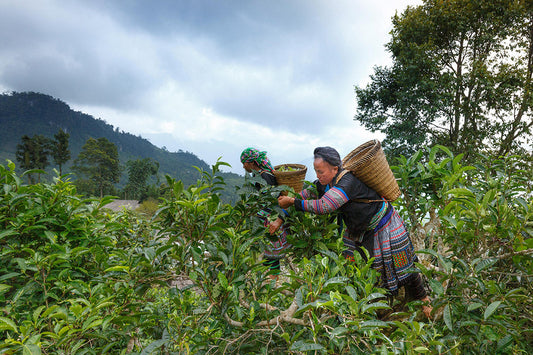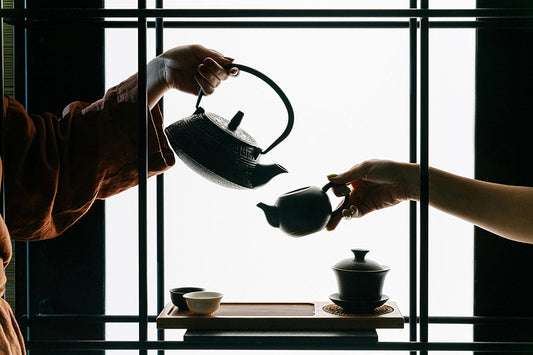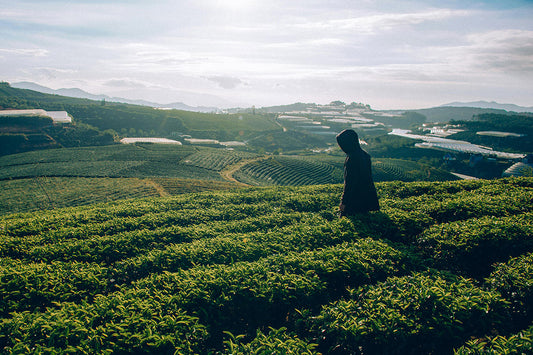In recent years, matcha has become a global phenomenon. From Instagram-worthy lattes to antioxidant-packed smoothies and ceremonial tea rituals, this vibrant green powder has captured the curiosity of health enthusiasts, foodies, and tea connoisseurs alike.
But what exactly is matcha? And what makes it different from regular green tea?
In this comprehensive guide, we’ll explore matcha’s origins, how it’s made, the different grades available, its health benefits, and how to prepare it — both traditionally and creatively. Whether you're completely new to matcha or simply want to deepen your knowledge, you’ll find everything you need to know right here.
What Is Matcha?
Matcha is a finely ground powder made from specially grown and processed green tea leaves, typically from the Camellia sinensis plant, the same plant used to make all true teas (black, green, white, oolong, etc.).
Unlike other types of green tea where the leaves are steeped and discarded, matcha is whisked into hot water and consumed entirely. This means you ingest the whole leaf and all its nutritional compounds.
What makes matcha unique isn’t just its powdered form, it’s the careful cultivation, shade-growing, and stone grinding process that results in its brilliant color, creamy texture, and rich umami flavor.
A Brief History of Matcha
Matcha’s story begins in China, during the Tang Dynasty (7th–10th century), where powdered tea was first used in Buddhist rituals. But it was Japan that transformed matcha into a cultural icon.
In the 12th century, the Zen monk Eisai brought powdered tea to Japan from China. He emphasized tea’s meditative qualities and health benefits. Over time, matcha became central to chanoyu, the Japanese tea ceremony, a spiritual practice that celebrates simplicity, presence, and harmony.
Today, matcha remains deeply rooted in Japanese tradition while also enjoying modern reinvention worldwide.
How Is Matcha Made?
Making authentic matcha involves meticulous farming and processing techniques. Here’s how it’s done:
1. Shade Growing
About 3–4 weeks before harvest, matcha tea plants are covered with shade cloths. This:
-
Slows photosynthesis,
-
Boosts chlorophyll production,
-
Increases amino acids (especially L-theanine, which enhances relaxation),
-
Produces a vibrant green color and mellow flavor.
2. Hand Picking
Only the youngest, most tender leaves from the top of the plant are selected — these contain the highest concentration of nutrients and sweetness.
3. Steaming
The leaves are quickly steamed to prevent oxidation, preserving their green color and nutritional value.
4. Drying & Destemming
After drying, the leaves (called tencha) are carefully destemmed and deveined.
5. Stone Grinding
The tencha is ground into a superfine powder using traditional granite stone mills, a slow process that preserves the flavor and aroma.
The result? A luxurious, vibrant powder ready for your bowl, cup, or latte.
Matcha Grades: Ceremonial vs. Culinary
Matcha is typically divided into two main grades:
1. Ceremonial Grade
-
Highest quality, made from first-harvest leaves.
-
Bright green color, fine texture.
-
Delicate, sweet, umami flavor.
-
Best for traditional whisking with water.
-
Used in Japanese tea ceremonies.
2. Culinary Grade
-
Slightly more bitter, less vibrant in color.
-
Still nutritious but made from later harvests.
-
Ideal for use in lattes, smoothies, baking, and savory dishes.
There’s also premium culinary and latte-grade matcha, which fall between ceremonial and standard culinary grade in both quality and price.
The Taste of Matcha
Describing matcha’s flavor is like describing wine, complex and layered. Good matcha is:
-
Smooth and creamy
-
Slightly sweet with a vegetal, grassy taste
-
Rich in umami (a savory flavor unique to Japanese cuisine)
-
Occasionally with nutty or floral notes
Lower-quality matcha may taste bitter, dull, or chalky — often a result of improper processing or poor leaf selection.
Is Matcha Healthy?
Absolutely. Because you consume the entire leaf, matcha delivers more nutrients than steeped green tea. Here are some of its key benefits:
Rich in Antioxidants
Matcha is packed with catechins, especially EGCG (epigallocatechin gallate), which help:
-
Neutralize free radicals,
-
Support heart health,
-
Combat inflammation,
-
Boost metabolism.
One cup of matcha can contain up to 137x more antioxidants than regular green tea.
Natural Energy Boost
Thanks to its combination of caffeine and L-theanine, matcha offers a calm, focused energy without the crash often associated with coffee.
Supports Mental Focus
L-theanine promotes alpha brain waves, associated with relaxation and clarity. Monks have long used matcha to stay alert during meditation.
Detoxifying Properties
The high chlorophyll content may support gentle detoxification and liver health.
Immune Support
Matcha provides vitamins (A, C, E, K), minerals (selenium, chromium, zinc), and fiber — a solid nutritional boost in every cup.
How to Make Matcha: Traditional Method
Preparing matcha the traditional way is a calming ritual. Here's what you'll need:
Tools:
-
Chawan (matcha bowl)
-
Chasen (bamboo whisk)
-
Chashaku (bamboo scoop)
-
Fine sieve (optional)
Ingredients:
-
1–2 grams of matcha (about 1–2 chashaku scoops)
-
60–70 ml of hot water (about 75–80°C / 170–175°F)
Steps:
-
Sift matcha into the bowl (prevents clumping).
-
Add a small amount of hot water.
-
Whisk in a “W” motion until frothy with small bubbles on top.
-
Sip and enjoy mindfully.
This is known as usucha (thin tea). For a thicker, more intense version (koicha), use more matcha and less water — without whisking to foam.
How to Make a Matcha Latte
Matcha’s versatility makes it ideal for modern drinks. Here’s a quick recipe for a delicious matcha latte:
Ingredients:
-
1 tsp matcha powder
-
2 oz hot water
-
6 oz milk (dairy or plant-based like oat, almond, or soy)
-
Sweetener (optional: honey, maple syrup, or agave)
Steps:
-
Sift and whisk the matcha with hot water.
-
Heat and froth the milk separately.
-
Combine milk with matcha in a cup.
-
Sweeten to taste and enjoy hot or iced.
You can also blend matcha into smoothies, sprinkle it on yogurt, or even use it in desserts like cakes, cookies, or ice cream.
How to Store Matcha
To preserve its freshness, store matcha:
-
In an airtight, opaque container,
-
In a cool, dark place or refrigerator,
-
Away from light, air, moisture, and strong odors.
Opened matcha is best consumed within 1–2 months for peak flavor and potency.
Common Questions About Matcha
Is matcha caffeinated?
Yes, a typical serving (1 gram) contains about 30–70 mg of caffeine, depending on the grade. That’s less than coffee but more than regular green tea.
Can I drink matcha every day?
Yes — many people enjoy 1–2 cups per day. Its antioxidants and calming properties make it ideal for regular use.
Is matcha safe during pregnancy?
While matcha is generally safe, pregnant or breastfeeding women should limit caffeine intake. Consult a healthcare provider for personalized advice.
Is all green tea matcha?
No. While all matcha is green tea, not all green tea is matcha. Matcha is grown and processed differently, resulting in a more concentrated and nutrient-rich product.
Matcha Around the World
From Japan to the West, matcha has found new life in cafes, bakeries, and home kitchens. Popular matcha products now include:
-
Matcha protein shakes
-
Matcha chocolate bars
-
Matcha face masks
-
Matcha energy bites
-
Matcha cocktails (yes, really!)
And yet, despite its trendiness, matcha remains a symbol of mindfulness and tradition — a bridge between ancient wisdom and modern wellness.
So, what is matcha?
It’s not just a powdered tea. It’s a ritual, a superfood, and a celebration of nature’s elegance. Whether you sip it from a handmade ceramic bowl or enjoy it iced with oat milk on your commute, matcha invites you to slow down, be present, and nourish your body and mind.
At TisforTea.com, we believe matcha is more than just a drink — it’s an experience. Explore our curated collection of ceremonial and culinary matcha, discover brewing tools, and find tips for integrating matcha into your daily life.
Because tea isn’t just what you drink. It’s how you live.






